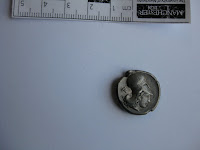During Week 7, our seminar was led by Dr. Liz Stewart, the Curator of Archaeology and the Historic Environment at the new Museum of Liverpool. This was an excellent opportunity to learn more about the process of planning and building a completely new museum. The Museum of Liverpool has used four main themes to tell the story of Liverpool; the museum space is divided into Port City, Global City, Creative City and People's City, and also contains Little Liverpool (a gallery for children) and the History Detectives. Archaeology is used in all of the galleries as the aim was for each gallery to contain a mix of collection types. All of the galleries also use a mix of permanent and temporary exhibitions and have a space for community exhibitions.
In order to build the museum, it was necessary to excavate part of the Manchester Dock, which was shown on a special episode of Time Team. The National Museums Liverpool's archaeology team undertook the excavation, and finds from the site are used in the gallery (such as an incised masonry block used in an alphabet wall in the Little Liverpool Gallery). Dr Stewart discussed the issues that can arise from using archaeology in display, and emphasised the importance of thinking creatively.
The Museum of Liverpool opens in phases from Spring 2011 but, if you can't wait until then, you can follow the museum's progress on Twitter:
http://twitter.com/the_new_museum
or on the National Museums Liverpool website:
http://www.liverpoolmuseums.org.uk/about/capitalprojects/mol/index.aspx
Also this week, our group finalised all of the objects that are to be included in the catalogue, the text and content of which was standardised by three group members. This week's tasks have also included working on the presentation of the catalogue, the portfolio and the presentation. We will be meeting to practice our presentation before the official event on Tuesday. Wish us luck!
(Written by Catherine Downey)




















